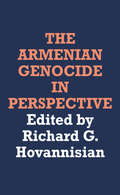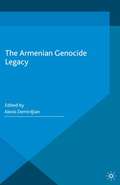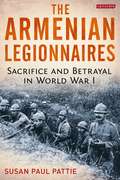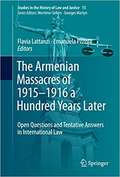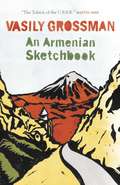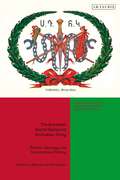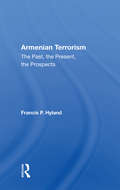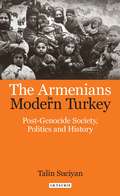- Table View
- List View
The Armenian Genocide in Perspective
by Stephen R. GraubardSeven decades after the destruction of the Armenian population in the Ottoman Empire, the Armenian genocide remains largely ignored by governments and forgotten by the world public, even though the annihilation of Armenians was headlined around the world in 1915. Scholarly investigation of the Armenian genocide is just beginning, made more difficult by the tendency of many establishment figures to rationalize the past and the attempt of perpetrator governments and their successors to deny the past.This volume is a pioneering collective attempt to assess and analyze the Armenian genocide from differing perspectives, including history, political science, ethics, religion, literature, and psychiatry. Focusing on the general implications of denial, rationalization, and responsibility, it is particularly important as a precursor to the study of the Holocaust and other genocides.
The Armenian Genocide in Perspective
by Richard G. HovannisianSeven decades after the destruction of the Armenian population in the Ottoman Empire, the Armenian genocide remains largely ignored by governments and forgotten by the world public, even though the annihilation of Armenians was headlined around the world in 1915. Scholarly investigation of the Armenian genocide is just beginning, made more difficult by the tendency of many establishment figures to rationalize the past and the attempt of perpetrator governments and their successors to deny the past.This volume is a pioneering collective attempt to assess and analyze the Armenian genocide from differing perspectives, including history, political science, ethics, religion, literature, and psychiatry. Focusing on the general implications of denial, rationalization, and responsibility, it is particularly important as a precursor to the study of the Holocaust and other genocides.
The Armenian Genocide Legacy (Palgrave Studies in the History of Genocide)
by Alexis DemirdjianThis volume focuses on the impact of the Armenian Genocide on different academic disciplines at the crossroads of the centennial commemorations of the Genocide. Its interdisciplinary nature offers the opportunity to analyze the Genocide from different angles using the lens of several fields of study.
The Armenian Gospel of the Infancy: with three early versions of the Protevangelium of James
The various versions of the Infancy Gospels illustrate how stories about the Virgin and Child lend themselves to be told and retold - much like the stories in the canonical Gospels. This first translation of the full text of the Armenian Gospel of the Infancy, itself derived from a sixth-century Syriac text that no longer exists, provides two variants of the famous narrative and several recensions or ancient editions. Stories about Jesus, many of them unique to this gospel, are included to show how he exercised his sovereign and divine will even as a child. This edition also contains three early Armenian versions of the Protevangelium of James, which with other ancient sources dependent on it (like the Infancy Gospel of Thomas and the Gospel of Pseudo-Matthew) constitute the basic tradition in the formation of the later Infancy Gospels. These writings are our earliest sources about the parents of the Virgin Mary (Joachim and Anne) and her miraculous birth. They also form the basis for the dogma of her Immaculate Conception and perpetual virginity after the birth of Jesus, and lay the ground for certain of the Marian feasts celebrated since the fourth century. Terian's engaging introduction and annotation of the texts place this rare document clearly in its cultural and historical context and provide extensive references to the surrounding textual tradition. These extraordinary stories will appeal to all with an interest in the early church.
The Armenian Legionnaires: Sacrifice and Betrayal in World War I
by Susan Paul PattieFollowing the devastation resulting from the Armenian Genocide in the Ottoman Empire beginning in 1915, the survivors of the massacres were dispersed across the Middle East, Europe and North and South America. Not content with watching World War I silently from the sidelines, a large number of Armenian volunteers joined the Legion d'Orient. They were trained in Cyprus and fought courageously in Palestine and Cilicia alongside Allied commander General Allenby, eventually playing a crucial role in defeating German and Ottoman forces in Palestine at the Battle of Arara in September 1918.The Armenian Legionnaires signed up on the understanding that they would be fighting in Syria and Turkey, and, should the Allies be successful, they would be part of an occupying army in their old homelands, laying the foundation for a self-governing Armenian state. Susan Paul Pattie describes the motivations and dreams of the Armenian Legionnaires and their ultimate betrayal as the French and the British shifted priorities, leaving their ancestral Armenian homelands to the emerging Republic of Turkey. Complete with eyewitness accounts, letters and photographs, this book provides an insight into relations between the Great Powers through the lens of a small, vulnerable people caught in a war that was not their own, but which had already destroyed their known world.
The Armenian Massacres of 1915–1916 a Hundred Years Later: Open Questions and Tentative Answers in International Law (Studies in the History of Law and Justice #15)
by Flavia Lattanzi Emanuela PistoiaThis peer-reviewed book features essays on the Armenian massacres of 1915-1916. It aims to cast light upon the various questions of international law raised by the matter. The answers may help improve international relations in the region. In 1915-1916, roughly a million and a half Armenians were murdered in the territory of the Ottoman Empire, which had been home to them for centuries. Ever since, a dispute between Armenians and Turkey has been ongoing over the qualification of the massacres. The contributors to this volume examine the legal nature and consequences of this event. Their investigation strives to be completely neutral and technical. The essays also look at the broader issue of denial. For instance, in Turkey, public speech on the matter can still trigger criminal prosecution whereas in other European States denial of genocide, war crimes and crimes against humanity is criminalized. However, the European Court of Human Rights views criminal prosecution of denial of the Armenian massacres as unlawful. In addition, one essay considers a state’s obligation to remember by looking at lessons learnt from the Inter-American Court of Human Rights. Another contributor looks at a collective right to remember and some ideas to move forward towards a solution. Moreover, the book explores the way the Armenian massacres have affected the relationship between Turkey and the European Union.
An Armenian Mediterranean: Words and Worlds in Motion (Mediterranean Perspectives)
by Kathryn Babayan Michael PiferThis book rethinks the Armenian people as significant actors in the context of Mediterranean and global history. Spanning a millennium of cross-cultural interaction and exchange across the Mediterranean world, essays move between connected histories, frontier studies, comparative literature, and discussions of trauma, memory, diaspora, and visual culture. Contributors dismantle narrow, national ways of understanding Armenian literature; propose new frameworks for mapping the post-Ottoman Mediterranean world; and navigate the challenges of writing national history in a globalized age. A century after the Armenian genocide, this book reimagines the borders of the “Armenian,” pointing to a fresh vision for the field of Armenian studies that is omnivorously comparative, deeply interconnected, and rich with possibility.
An Armenian Mediterranean: Words and Worlds in Motion (Mediterranean Perspectives)
by Kathryn Babayan Michael PiferThis book rethinks the Armenian people as significant actors in the context of Mediterranean and global history. Spanning a millennium of cross-cultural interaction and exchange across the Mediterranean world, essays move between connected histories, frontier studies, comparative literature, and discussions of trauma, memory, diaspora, and visual culture. Contributors dismantle narrow, national ways of understanding Armenian literature; propose new frameworks for mapping the post-Ottoman Mediterranean world; and navigate the challenges of writing national history in a globalized age. A century after the Armenian genocide, this book reimagines the borders of the “Armenian,” pointing to a fresh vision for the field of Armenian studies that is omnivorously comparative, deeply interconnected, and rich with possibility.
Armenian Organization and Ideology Under Ottoman Rule: 1908-1914
by Dikran KaligianThis book provides a comprehensive picture of Armeno-Turkish relations for the brief period of Ottoman Constitutional rule between 1908 and 1914. Kaligian integrates internal documents of the Armenian Revolutionary Federation, and existing research on the last years of the empire, as well as the archives of the British, American, and German diplomatic corps. By reducing the overemphasis on central government policies and by describing unofficial contacts, political relations, and provincial administration and conditions, Kaligian provides a unified account of this key period in Ottoman history. Kaligian sets out to resolve many of the conflicting conclusions in the current historiography-including the most central issue, the Armenian Revolutionary Federation relations with the Turkish Committee of Union and Progress. It is impossible to obtain a true picture of Armeno-Turkish relations without an accurate analysis of their two leading parties. This study finds that the ARF was torn between maintaining relations with a CUP that had failed to implement promised reforms and was doing little to prevent increasing attacks on the Armenian population, or break off relations thus ending any realistic chance for the constitutional system to succeed. The party continued to stake its reputation and resources on the success of constitutional government even after the trauma of the 1909 Adana massacres. The decisive issue was the failure of land reform. This book sets the record straight in terms of understanding Armeno-Turkish relations during this short but pivotal period. Kaligian's study, the first of its kind, shows that the party's internal deliberations support the conclusion that it did remain loyal and contradicts the view that the party's only aim was to incite a rebellion against Ottoman rule. The author has done an excellent job of leading the reader through this rich history, using primary source information to bridge the gaps from theory, to analysis, to evidence.
Armenian Organization and Ideology Under Ottoman Rule: 1908-1914
by Dikran KaligianThis book provides a comprehensive picture of Armeno-Turkish relations for the brief period of Ottoman Constitutional rule between 1908 and 1914. Kaligian integrates internal documents of the Armenian Revolutionary Federation, and existing research on the last years of the empire, as well as the archives of the British, American, and German diplomatic corps. By reducing the overemphasis on central government policies and by describing unofficial contacts, political relations, and provincial administration and conditions, Kaligian provides a unified account of this key period in Ottoman history. Kaligian sets out to resolve many of the conflicting conclusions in the current historiography-including the most central issue, the Armenian Revolutionary Federation relations with the Turkish Committee of Union and Progress. It is impossible to obtain a true picture of Armeno-Turkish relations without an accurate analysis of their two leading parties. This study finds that the ARF was torn between maintaining relations with a CUP that had failed to implement promised reforms and was doing little to prevent increasing attacks on the Armenian population, or break off relations thus ending any realistic chance for the constitutional system to succeed. The party continued to stake its reputation and resources on the success of constitutional government even after the trauma of the 1909 Adana massacres. The decisive issue was the failure of land reform. This book sets the record straight in terms of understanding Armeno-Turkish relations during this short but pivotal period. Kaligian's study, the first of its kind, shows that the party's internal deliberations support the conclusion that it did remain loyal and contradicts the view that the party's only aim was to incite a rebellion against Ottoman rule. The author has done an excellent job of leading the reader through this rich history, using primary source information to bridge the gaps from theory, to analysis, to evidence.
An Armenian Sketchbook
by Vasily GrossmanFew writers had to confront so many of the last century's mass tragedies as Vasily Grossman. He is likely to be remembered, above all, for the terrifying clarity with which he writes about the Shoah, the Battle of Stalingrad and the Terror Famine in the Ukraine. An Armenian Sketchbook, however, shows us a very different Grossman; it is notable for its warmth, its sense of fun and for the benign humility that is always to be found in his writing. After the 'arrest' - as Grossman always put it - of Life and Fate, Grossman took on the task of editing a literal Russian translation of a lengthy Armenian novel. The novel was of little interest to him, but he was glad of an excuse to travel to Armenia. This is his account of the two months he spent there. It is by far the most personal and intimate of Grossman's works, with an air of absolute spontaneity, as though Grossman is simply chatting to the reader about his impressions of Armenia - its mountains, its ancient churches and its people.
The Armenian Social Democrat Hnchakian Party: Politics, Ideology and Transnational History (Armenians in the Modern and Early Modern World)
by Bedross Der MatossianThis book, based on new research, sheds light on the history of the Social Democrat Hnchakian Party, a major Armenian revolutionary party that operated in the Ottoman Empire, Russia, Persia and throughout the global Armenian diaspora. Divided into sections which cover the origins, ideology, and regional history of the SDHP, the book situates the history of the Hnchaks within debates around socialism, populism, and nationalism in the 19th and 20th centuries. The SDHP was not only an Armenian party but had a global Marxist outlook, and scholars in this volume bring to bear expertise in a wide range of histories and languages including Russian, Turkish, Persian and Latin American to trace the emergence and role this influential party played from their split with the Armenian Revolutionary Federation and the events of the Armenian genocide to the formation of the first Armenian Republic and then Soviet Armenia. Putting the Hnchaks in context as one of many nationalist radical groups to emerge in Eurasia in the late 19th century, the book is an important contribution to Armenian historiography as well as that of transnational revolutionary movements in general.
The Armenian Social Democrat Hnchakian Party: Politics, Ideology and Transnational History (Armenians in the Modern and Early Modern World)
This book, based on new research, sheds light on the history of the Social Democrat Hnchakian Party, a major Armenian revolutionary party that operated in the Ottoman Empire, Russia, Persia and throughout the global Armenian diaspora. Divided into sections which cover the origins, ideology, and regional history of the SDHP, the book situates the history of the Hnchaks within debates around socialism, populism, and nationalism in the 19th and 20th centuries. The SDHP was not only an Armenian party but had a global Marxist outlook, and scholars in this volume bring to bear expertise in a wide range of histories and languages including Russian, Turkish, Persian and Latin American to trace the emergence and role this influential party played from their split with the Armenian Revolutionary Federation and the events of the Armenian genocide to the formation of the first Armenian Republic and then Soviet Armenia. Putting the Hnchaks in context as one of many nationalist radical groups to emerge in Eurasia in the late 19th century, the book is an important contribution to Armenian historiography as well as that of transnational revolutionary movements in general.
Armenian Terrorism: The Past, The Present, The Prospects
by Francis P HylandArising seemingly out of nowhere, Armenian terrorist groups in the last two decades have carried out over 200 attacks in some two dozen countries around the world. Although this wave of terror at first appears to have sprung up without warning, a closer look at Armenian history, especially since World War I, shows that it is only the most recent in a series of outbreaks of ethnic violence. In this study, the author examines the social and political background of Armenian terrorism and its similarities to and differences from other terrorist movements, and he carefully dissects the organizational methods of these groups. An important feature of the work is an extensive and detailed chronology of Armenian terrorism from 1915 to the present. Each entry provides essential information concerning the date and time of the attack, location, victims, weapons used, terrorist groups and individual commandos responsible for the attack, and a list of sources for further reference. A resource for specialists studying terrorism and ethnic violence, "Armenian Terrorism" should also be useful to those interested in the tragic and difficult history of Armenia and Turkey.
Armenian Terrorism: The Past, The Present, The Prospects
by Francis P HylandArising seemingly out of nowhere, Armenian terrorist groups in the last two decades have carried out over 200 attacks in some two dozen countries around the world. Although this wave of terror at first appears to have sprung up without warning, a closer look at Armenian history, especially since World War I, shows that it is only the most recent in a series of outbreaks of ethnic violence. In this study, the author examines the social and political background of Armenian terrorism and its similarities to and differences from other terrorist movements, and he carefully dissects the organizational methods of these groups. An important feature of the work is an extensive and detailed chronology of Armenian terrorism from 1915 to the present. Each entry provides essential information concerning the date and time of the attack, location, victims, weapons used, terrorist groups and individual commandos responsible for the attack, and a list of sources for further reference. A resource for specialists studying terrorism and ethnic violence, "Armenian Terrorism" should also be useful to those interested in the tragic and difficult history of Armenia and Turkey.
The Armenians: A People in Exile (David Marshall Lang's Journey from Russia to Armenia via Caucasian Georgia #5)
by David Marshall LangOriginally published in 1981, this book tells the story of the Armenian dispersion and gives a graphic account of the persecution of the Armenians by the Turks from 1895 to 1922 which foreshadowed the Jewish holocaust at the hands of Hitler, who is said to have modelled some of his own ideas on those of the Young Turks. Drawing upon material from little-known sources, this book follows the trail of the Armenians from their native lands around Mount Ararat to such far-flung spots as lhasa, Harbin and Buenos Aires. This lively and readable book is an excellent account of a people who have been partly in exile for some 2,000 years.
The Armenians: A People in Exile (David Marshall Lang's Journey from Russia to Armenia via Caucasian Georgia #5)
by David Marshall LangOriginally published in 1981, this book tells the story of the Armenian dispersion and gives a graphic account of the persecution of the Armenians by the Turks from 1895 to 1922 which foreshadowed the Jewish holocaust at the hands of Hitler, who is said to have modelled some of his own ideas on those of the Young Turks. Drawing upon material from little-known sources, this book follows the trail of the Armenians from their native lands around Mount Ararat to such far-flung spots as lhasa, Harbin and Buenos Aires. This lively and readable book is an excellent account of a people who have been partly in exile for some 2,000 years.
Armenians Beyond Diaspora: Making Lebanon their Own (Alternative Histories)
by Tsolin NalbantianThis book argues that Armenians around the world – in the face of the Genocide, and despite the absence of an independent nation-state after World War I – developed dynamic socio-political, cultural, ideological and ecclesiastical centres. And it focuses on one such centre, Beirut, in the postcolonial 1940s and 1950s. Tsolin Nalbantian explores Armenians’ discursive re-positioning within the newly independent Lebanese nation-state; the political-cultural impact (in Lebanon as well as Syria) of the 1946–8 repatriation initiative to Soviet Armenia; the 1956 Catholicos election; and the 1957 Lebanese elections and 1958 mini-civil war. What emerges is a post-Genocide Armenian history of – principally – power, renewal and presence, rather than one of loss and absence.
The Armenians in Modern Turkey: Post-Genocide Society, Politics and History (Library of Ottoman Studies)
by Talin SuciyanAfter the Armenian genocide of 1915, in which over a million Armenians died, thousands of Armenian-Turks lived and worked in the Turkish state alongside those who had persecuted their communities. Living under heavy censorship, and in an atmosphere of official denial that the deaths were a genocide, how did Turkish Armenians record their own history? Here, Talin Suciyan explores the life experienced by Turkey's Armenian communities as Turkey's great modernisation project of the 20th century gathered pace.Suciyan achieves this through analysis of remarkable new primarymaterial: Turkish state archives, minutes of the Armenian National Assembly, a kaleidoscopic series of personal diaries, memoirs and oral histories, various Armenian periodicals such as newspapers, yearbooks and magazines, as well as statutes and laws which led to the continuing persecution of Armenians. The first history of its kind, The Armenians in Modern Turkey is a fresh contribution to the history of modern Turkey and the Armenian experience there
Armenians in the Byzantine Empire: Identity, Assimilation and Alienation from 867 to 1098
by Toby BromigeArmenians in the Byzantine Empire is a new study exploring the relationship between the Armenians and Byzantines from the ninth through eleventh centuries. Utilising primary sources from multiple traditions, the evidence is clear that until the eleventh century Armenian migrants were able to fully assimilate into the Empire, in time recognized fully as Romaioi (Byzantine Romans). From the turn of the eleventh century however, migrating groups of Armenians seem to have resisted the previously successful process of assimilation, holding onto their ancestral and religious identity, and viewing the Byzantines with suspicion. This stagnation and ultimate failure to assimilate Armenian migrants into Byzantium has never been thoroughly investigated, despite its dire consequences in the late eleventh century when the Empire faced its most severe crisis since the rise of Islam, the arrival and settlement of the Turkic peoples in Anatolia.
Armenians in the Byzantine Empire: Identity, Assimilation and Alienation from 867 to 1098
by Toby BromigeArmenians in the Byzantine Empire is a new study exploring the relationship between the Armenians and Byzantines from the ninth through eleventh centuries. Utilising primary sources from multiple traditions, the evidence is clear that until the eleventh century Armenian migrants were able to fully assimilate into the Empire, in time recognized fully as Romaioi (Byzantine Romans). From the turn of the eleventh century however, migrating groups of Armenians seem to have resisted the previously successful process of assimilation, holding onto their ancestral and religious identity, and viewing the Byzantines with suspicion. This stagnation and ultimate failure to assimilate Armenian migrants into Byzantium has never been thoroughly investigated, despite its dire consequences in the late eleventh century when the Empire faced its most severe crisis since the rise of Islam, the arrival and settlement of the Turkic peoples in Anatolia.
The Armenians in the Medieval Islamic World: Medieval Cosmopolitanism and Images of Islamthirteenth to Fourteenth Centuries (Armenian Studies)
by Seta B. DadoyanIn the third volume of the trilogy, Seta B. Dadoyan focuses on social and cultural aspects, rather than the core political focus exhibited in her first two volumes. Her objective is to suggest political readings of these themes and related texts by revealing hitherto unstudied and novel interactions in the cities of Asia Minor during the Mongol Period.Dadoyan focuses on the Armenian condition and role in the medieval Islamic world. She argues that if the entire region was the habitat of most of the Armenians, their history too is part of these locations and peoples. Dadoyan draws the outlines of a new philosophy of Armenian history based on hitherto obscured patterns of interaction.The first three chapters of this volume are dedicated to the images of Prophet Muhammad in Armenian literature. Dadoyan shows that direct interactions and borrowings happened regularly from Islamic sciences, reform projects, poetry, and arts. Dadoyan argues that the cosmopolitan urban environments were radically different from rural areas and close interactions took different and unexpected patterns. In the last part of the volume, she presents the first and only polemical-apologetic Armenian texts addressed to Islam at the end of the fourteenth century. This book is essential for all historians and Middle East scholars and is the latest volume in Transaction's Armenian Studies series.
The Armenians in the Medieval Islamic World: Medieval Cosmopolitanism and Images of Islamthirteenth to Fourteenth Centuries
by Seta B. DadoyanIn the third volume of the trilogy, Seta B. Dadoyan focuses on social and cultural aspects, rather than the core political focus exhibited in her first two volumes. Her objective is to suggest political readings of these themes and related texts by revealing hitherto unstudied and novel interactions in the cities of Asia Minor during the Mongol Period.Dadoyan focuses on the Armenian condition and role in the medieval Islamic world. She argues that if the entire region was the habitat of most of the Armenians, their history too is part of these locations and peoples. Dadoyan draws the outlines of a new philosophy of Armenian history based on hitherto obscured patterns of interaction.The first three chapters of this volume are dedicated to the images of Prophet Muhammad in Armenian literature. Dadoyan shows that direct interactions and borrowings happened regularly from Islamic sciences, reform projects, poetry, and arts. Dadoyan argues that the cosmopolitan urban environments were radically different from rural areas and close interactions took different and unexpected patterns. In the last part of the volume, she presents the first and only polemical-apologetic Armenian texts addressed to Islam at the end of the fourteenth century. This book is essential for all historians and Middle East scholars and is the latest volume in Transaction's Armenian Studies series.
The Armenians in the Medieval Islamic World: The Arab Period in Armnyahseventh to Eleventh Centuries
by Seta B. DadoyanIn this first of a massive three-volume work, Seta B. Dadoyan studies the Armenian experience in the medieval Islamic world and takes the reader through hitherto undiscovered paradigmatic cases of interaction with other populations in the region. Being an Armenian, Dadoyan argues, means having an ethnic ancestry laden with narratives drawn from the vast historic Armenian habitat. Contradictory trends went into the making of Armenian history, yet most narratives fail to reflect this rich texture. Linking Armenian-Islamic history is one way of dealing with the problem. Dadoyan's concern is also to outline revolutionary elements in the making of Armenian ideologies and politics. This extensive work captures the multidimensional nature of the Armenian experience in the medieval Islamic world. The author holds that every piece of literature, including historical writing, is an artifact. It is a composition of many elements arranged in certain forms: order, sequence, proportion, detail, intensity, etc. The author has composed and arranged the larger subjects and their sub-themes in such a way as to create an open, dynamic continuity to Armenian history that is intellectually intriguing, aesthetically appealing, and close to lived experiences.
The Armenians in the Medieval Islamic World: Armenian Realpolitik in the Islamic World and Diverging Paradigmscase of Cilicia Eleventh to Fourteenth Centuries
by Seta B. DadoyanIn the second of a three-volume work, Seta B. Dadoyan explores the Armenian condition from the 970s to the end of the fourteenth century. This period marked the gradual loss of semi-autonomy on the traditional mainland and the rise of Armenian power of diverging patterns in southeastern Asia Minor, north Syria, Cilicia, and Egypt. Dadoyan's premise is that if Armenians and Armenia have always been located in the Middle East and the Islamic world, then their history is also a natural part of that region and its peoples. She observes that the Armenian experience has been too complicated to be defined by simplistic constructs centered on the idea of a heroic, yet victimized nation. She notes that a certain politics of historical writing, supported by a culture of authority, has focused sharply on episodes and, in particular, on the genocide. For her sources, Dadoyan has used all available and relevant (primary and secondary) Armenian sources, as well as primary Arab texts and sources. This book will stimulate re-evaluation of the period, and re-conceptualizing Armenian and Middle Eastern histories.
